Temnothorax anaphalantus
| Temnothorax anaphalantus | |
|---|---|

| |
| Scientific classification | |
| Kingdom: | Animalia |
| Phylum: | Arthropoda |
| Class: | Insecta |
| Order: | Hymenoptera |
| Family: | Formicidae |
| Subfamily: | Myrmicinae |
| Tribe: | Crematogastrini |
| Genus: | Temnothorax |
| Species group: | andrei |
| Species: | T. anaphalantus |
| Binomial name | |
| Temnothorax anaphalantus Snelling, Borowiec & Prebus, 2014 | |
Little is known of the ecology of this species. Some specimens were collected from a pitfall sample in an area that is mostly oak grassland but including some coastal scrub and riparian scrub. Other records are from chaparral and a cottonwood riparian area. The only nest sample of T. anaphalantus was collected from dead wood in montane chaparral. (Snelling et al. 2014)
Identification
Prebus 2017 - A member of the andrei clade.
Snelling et al. (2014) - Head and mesosoma dull and reticulate; erect setae absent from frons and vertex; mesosomal dorsum with about 12 short stout setae; propodeal spines thick at base; petiole node rounded in profile; body color yellowish to light brown.
The reticulate head and mesosoma, without any obvious rugae, and the greatly reduced standing pilosity will separate this from any other western species. In Mackay’s key (2000) it will run to Temnothorax silvestrii from Arizona, but differs from both T. silvestrii and Temnothorax morongo by the greatly reduced pilosity, lack of rugae, and the much thicker, short propodeal spines.
Keys including this Species
Distribution
Latitudinal Distribution Pattern
Latitudinal Range: 34.32139° to 30.9833°.
| North Temperate |
North Subtropical |
Tropical | South Subtropical |
South Temperate |
- Source: AntMaps
Distribution based on Regional Taxon Lists
Nearctic Region: United States (type locality).
Neotropical Region: Mexico.
Distribution based on AntMaps
Distribution based on AntWeb specimens
Check data from AntWeb
Countries Occupied
| Number of countries occupied by this species based on AntWiki Regional Taxon Lists. In general, fewer countries occupied indicates a narrower range, while more countries indicates a more widespread species. |

|
Estimated Abundance
| Relative abundance based on number of AntMaps records per species (this species within the purple bar). Fewer records (to the left) indicates a less abundant/encountered species while more records (to the right) indicates more abundant/encountered species. |

|
Biology
Castes
Worker
Images from AntWeb
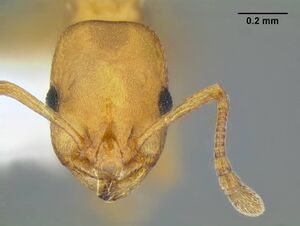   
| |
| Worker. Specimen code casent0339237. Photographer Marek Borowiec, uploaded by UC Davis Ant Group. | Owned by UCDC, Davis, CA, USA. |
Queen
Images from AntWeb
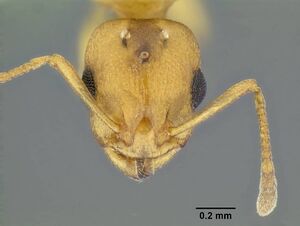 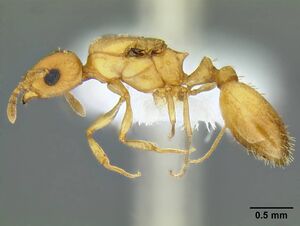  
| |
| Worker. Specimen code casent0339237. Photographer Marek Borowiec, uploaded by UC Davis Ant Group. | Owned by UCDC, Davis, CA, USA. |
Male
Images from AntWeb
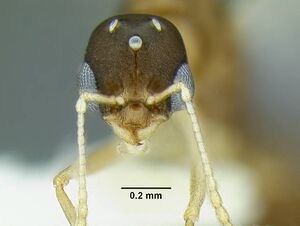  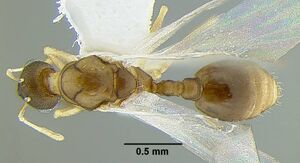 
| |
| Worker. Specimen code casent0339242. Photographer Marek Borowiec, uploaded by UC Davis Ant Group. | Owned by UCDC, Davis, CA, USA. |

| |
| Specimen code casent0339238. . | |
Nomenclature
The following information is derived from Barry Bolton's Online Catalogue of the Ants of the World.
- anaphalantus. Temnothorax anaphalantus Snelling, Borowiec & Prebus, 2014: 32, figs. 2–4, 19, 23–26 (w.q.m.) UNITED STATES.
Unless otherwise noted the text for the remainder of this section is reported from the publication that includes the original description.
Description
Worker
measurements (mm) (8 measured): EL 0.128–0.161 (0.145); HFL 0.433–0.486 (0.463); HFW 0.095–0.110 (0.104); HL 0.596–0.670 (0.647); HW 0.456–0.537 (0.505); IOD 0.395–0.457 (0.436); OMD 0.137–0.153 (0.147); PPW 0.200–0.229 (0.216); PSL 0.077–0.114 (0.100); PTW 0.147–0.170 (0.163); PW 0.299–0.350 (0.330); SL 0.419–0.463 (0.440); WL 0.662–0.746 (0.715). Indices: CI 76.5–80.3 (77.9); FI 88.3–95.0 (91.8); OI 21.4–24.3 (22.6); PI 125–138 (133); PSI 14.4–17.0 (15.5); SI 65.3–70.6 (67.9).
Head longer than broad in frontal view, lateral margins distinctly convergent above; posterior margin weakly concave in middle. Antenna 12-segmented; scape ending below posterior margin by more than twice its apical width; terminal club dis-tinctly three-segmented. Eye small and moderately bulging; IOD 2.81–3.12 × EL; EL 0.93–1.10 × OMD. Median lobe of clypeus without submedian carinae. Head, including median lobe of clypeus and supraclypeal area, dull and finely reticulate; very fine rugae curving around antennal fossae and extending a short distance back from frontal lobes. Vertex, frons and frontal lobes without erect setae; clypeus with a single erect seta on each side of median lobe in addition to usual long curled setae along anterior margin.
Mesosoma slender, WL 2.13–2.21 × PW; in profile, pronotum sloping slightly down from mesonotum, mesonotum plus metanotum nearly flat. Propodeal spines elongate-triangular with acute tips, PSI 14.4–17.0, nearly as long as distance between their bases. Entire mesosoma dull and finely reticulate; several very short cross-rugae present on lower metapleural suture and several longer rugae anterior to metapleural gland. Metafemur 4.28–4.63 times longer than wide in dorsal view. Erect setae distinctly flattened, with 4 anteriorly across pronotum, 2 anteriorly and 2 posteriorly on mesonotum+metanotum, 1 on each propodeal spine.
Petiole node highest anteriorly, rounded dorsal face sloping distad into posterior face; subpetiolar process short and thick. Postpetiole rounded in profile and quadrate in dorsal view. Both nodes dull and finely reticulate, without rugae and each with several flattened erect setae that are longer than those of mesosoma.
Gaster, in dorsal view, 2.51–3.02 times wider than postpetiole; basal half of first tergite slightly shiny and distinctly roughened, becoming increasingly shiny and more weakly sculptured distad; all segments with scattered short, erect or suberect flattened setae.
Head and body uniformly pale brownish yellow to light brown, gaster darker posteriorly.
Queen
measurements (1 measured): EL 0.212; HFL 0.614; HFW 0.110; HL 0.717; HW 0.594; IOD 0.496; OMD 0.150; PPW 0.289; PSL 0.146; PTW 0.203; PW 0.661; SL 0.531; WL 1.18. Indices: CI 82.8; FI 103; OI 29.6; PI 142; PSI 20.4; SI 74.1.
Head longer than broad, margins approximately parallel in frontal view and broadly rounded into transverse posterior margin. Antennal scape extending back to level of lateral ocellus. Eye large and moderately convex, IOD 2.34 × EL in frontal view; EL 1.41 × OMD. Sculpture and pilosity about as in worker but longitudinal rugae more pronounced and a pair of hairs arising anterior to lateral ocelli.
Mesosoma slender, WL 1.79 × PW. Mesonotum flat in profile. Propodeal spines extremely thick at base, PSI 20.4, about half as long as infraspinal distance. Mesoscutum reticulate with faint longitudinal rugae in posterolateral area; mesoscutellum reticulate. Side of pronotum, mesepisternum and propodeum, including declivity, reticulate without rugae. Pilosity suberect to erect, short (less than 0.1 mm), flattened and club-shaped.
Remainder as described for worker; gaster 3.17 times as wide as postpetiole.
Male
measurements (2 measured): EL 0.200–0.205 (0.203); HFL 0.590–0.622 (0.606); HFW 0.074–0.077 (0.076); HL 0.443–0.460 (0.452); HW 0.411–0.442 (0.427); IOD 0.282–0.300 (0.291); OMD 0.027–0.030 (0.028); PPW 0.189–0.190 (0.190); PSL N/A; PTW 0.135–0.139 (0.137); PW 0.425–0.466 (0.446); SL 0.170–0.177 (0.174); WL 0.891–0.927 (0.909). Indices: CI 92.8–96.1 (94.4); FI 141–144 (142); OI 43.5–46.3 (44.9); PI 1.37–1.40 (1.38); PSI N/A; SI 38.4–38.5 (38.4).
Head longer than broad, margins behind eyes slightly convergent and broadly rounded into weakly convex posterior margin. Eyes large and strongly bulging; IOD 1.38–1.50 × EL; OMD very short, about equal to transverse diameter of anterior ocellus; interocellar distance 2.30–2.70 and ocellocular distance 2.60–2.70 times diameter of anterior ocellus. Antennae 13-segmented. Scape more than half of IOD. Head uniformly punctate, with fine rugae present on clypeus and in the area between antennal fossae and compound eye, extending from lateral clypeal margin to approximately 1/2 length of compound eye. Pilosity same as in worker, but with clypeal setae barely surpassing the clypeal margin in full face view.
Mesosoma robust, WL 1.99–2.10 × PW. Propodeal spines absent. Sculpture punctate, weakening to fine reticulation on mesopleuron and dorsal surfaces of mesonotum. Mesoscutum with two pairs of erect short, blunt setae; several pairs of similar setae along the lateral and posterior margins of mesoscutellum.
Petiole subtriangular, with petiolar node rounded in profile; subpetiolar process a small rounded lobe, approximately half as high as length of propodeal lobes.
Gaster 2.82–3.09 × PPW in dorsal view. Uniformly smooth and shiny except for traces of fine reticulation on the anterior margin of first tergite. Sparse decumbent pilosity present on the first gastric sclerites, with several short, erect, blunt tipped setae along the posterior margins of all gastric sclerites.
Mesosoma and petiolar segments light brown; appendages light brownish yellow; head and gaster reddish brown.
Type Material
Holotype worker, U.S.A.: CALIFORNIA: Los Angeles Co.: Baldy Road, 34.23° -117.66°, 5.vii.1992 (G. C. Snelling) at public restrooms (LACMENT299332) Los Angeles County Museum of Natural History. Paratypes. Same data as holotype, 1 worker (LACMENT299331) LACM, 1 worker (LACMENT299330) Museum of Comparative Zoology.
Etymology
From Greek: anaphalantos, with a bald forehead, in allusion to the lack of erect setae on the vertex and posterior areas.
References
- Snelling, R.R., Borowiec, M.L. & Prebus, M.M. 2014. Studies on California ants: a review of the genus Temnothorax (Hymenoptera, Formicidae). ZooKeys 372:27–89. doi:10.3897/zookeys.372.6039
- Prebus, M.M. 2021. Taxonomic revision of the Temnothorax salvini clade (Hymenoptera: Formicidae), with a key to the clades of New World Temnothorax. PeerJ 9, e11514 (doi:10.7717/peerj.11514).
References based on Global Ant Biodiversity Informatics
- Des Lauriers J., and D. Ikeda. 2017. The ants (Hymenoptera: Formicidae) of the San Gabriel Mountains of Southern California, USA with an annotated list. In: Reynolds R. E. (Ed.) Desert Studies Symposium. California State University Desert Studies Consortium, 342 pp. Pages 264-277.
- Snelling R.R., M. L. Borowiec, and M. M. Prebus. 2014. Studies on California ants: a review of the genus Temnothorax (Hymenoptera, Formicidae). ZooKeys 372: 2789. doi: 10.3897/zookeys.372.6039

